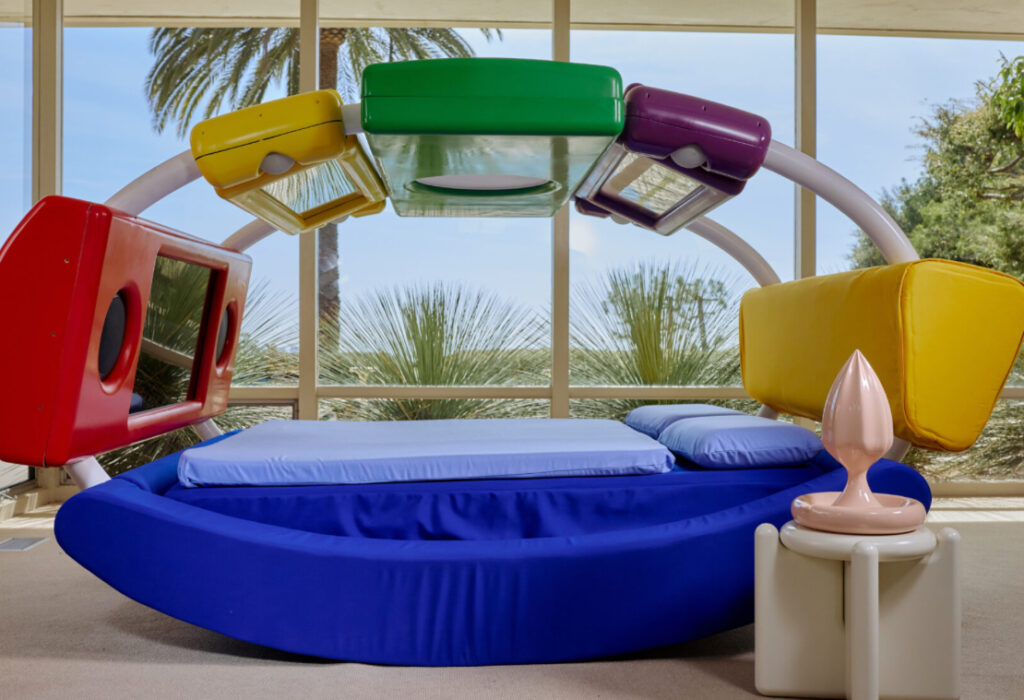A bed is many things: a terrain of sleep, a monument to rest, a charged stage for intimacy, and occasionally, a battlefield of negotiations. We build lives atop mattresses, layer them with longing and linens, and hope they’ll hold everything we throw onto and into them—love, conflict, dreams, phones, pets, others.
But what if the architecture of the bed itself—its width, its frame, its assumptions—was never designed for the complexity of contemporary relationships?
Enter Feeld, the dating app that champions ethical non-monogamy and sexual fluidity, and Gustaf Westman, the Swedish designer known for whimsical postmodern interiors. Together, they’ve released the first bed explicitly designed for non-monogamists: wide, curvaceous, modular, and emotionally attuned. It’s not just larger. It’s re-imagined.
The Premise: More Than Room for Two
Most beds sold in the western world—twin, full, queen, king—are scaled for binary logic: couples, pairs, dyads. The names say it all: “twin” for solo sleepers; “king” for a royal couple. Even the famed “California King” stretches long, not wide. These are beds built for couples by a culture that has fetishized coupledom.
But polyamorous, open, or relationship-anarchist configurations require more than room. They require redesign. They require spatial permission.
The Feeld x Westman bed breaks with the implied monogamy of the modern mattress. It is not just a supersized platform. It’s a physical reconsideration of how love, bodies, and arrangements can cohabitate fluidly.
The Form: Roundness as Invitation
The first thing you notice is the shape. The Feeld x Westman bed does not rely on angular austerity. Instead, it curves—softly, substantially, suggestively. With its pillowy tubular edges and modular add-ons, the bed feels less like a piece of furniture and more like a playground for trust.
The curves aren’t just aesthetic. They’re ethical gestures. Roundness eliminates hierarchy. There are no “sides of the bed,” no implied ownership of a half. The circular motifs, in both structure and tone, create zones of softness, not borders. Everyone is held.
In design terms, it’s an homage to emotional ergonomics. In intimacy terms, it’s a dare to rethink who belongs in your bed—and how.
The Materials: Tactile Consent
The bed’s construction honors the values of those who might use it. It’s made from sustainably sourced wood, low-VOC foam, and an upholstery blend that’s hypoallergenic and non-toxic—a nod to both ecological and bodily care. Feeld’s involvement ensures that nothing in the construction contradicts its ethics-first platform, which centers autonomy, transparency, and mutual respect.
Texture matters. The finish is matte, not slick—inviting contact, not conquest. It’s soft to the skin but not aggressively plush. It absorbs noise, tension, bodies. It’s a container, not a stage.
This isn’t furniture as flex. It’s furniture as philosophical apparatus.
The Function: Not Just Sleep, but Space
What makes the Feeld x Westman bed truly radical is not its visual profile but its functional ambition.
This bed isn’t merely larger. It’s adaptive.
- Extension panels can be added seamlessly, much like emotional agreements in poly relationships: with intention, communication, and a little creativity.
- A headboard shelf holds books, charging ports, toys, lube, and affirmations—recognizing that modern sleep doesn’t separate tech from touch.
- Weight distribution zones mean that movement in one quadrant doesn’t ripple through the whole bed. Each body’s presence is acknowledged but not overbearing.
In short, it’s a bed that behaves like a well-negotiated polycule: flexible, supportive, porous but bounded.
The Emotional Geometry of Design
Gustaf Westman is not a traditional furniture designer. His pieces—mirrors that wobble, tables that smile—exist in a world where emotional resonance trumps technical bravado. He designs from a place of sentimentality and satire, channeling a childlike curiosity into adult forms.
His collaboration with Feeld doesn’t betray this sensibility—it deepens it. The bed is not ironic. It’s intimate in the quietest, least sarcastic way. It understands the physics of sleep and the metaphysics of vulnerability. It holds both.
“Design should make you feel safe,” Westman has said. “Safe to be weird, safe to be many.”
It’s a bold proposition: that design might not just accommodate love, but cultivate it.
The Political Body in the Bedroom
A bed is never apolitical. Where we sleep, who we sleep beside, and how we do so are shaped by historical codes of respectability.
Non-monogamy challenges all of that. It questions ownership, scarcity, the myth of romantic completion. And so, a bed for non-monogamists cannot simply be a wider version of the old norm. It must reject the architecture of possession.
This bed is a political object. It does not assume that love must be triangulated back to a central, dominant axis. It allows for constellation thinking—a way of loving that isn’t a ladder, but a sky full of points, flickering in different rhythms, no two exactly the same.
Who Is This For?
The Feeld x Westman bed is not for everyone. But it is for those who need it most.
- For the queer couple who invites in a third without needing to make a choice.
- For the co-parents who share a home but not a sex life, and still sleep in overlapping constellations.
- For the solo person who loves widely and occasionally hosts sleepovers that last three nights with three different types of affection.
- For the relationship anarchists, the fluid, the many-hearted.
It’s a piece of design that says: We see you. We believe in your structure. We will not force you to fold into ours.
Desire as Spatial Practice
If desire can be spatial, then so must design. The Feeld x Westman bed performs an act of architectural reparation: it builds room where previously there was only metaphor. It offers surface for touch, silence for rest, openness for exit.
Unlike traditional “sexy” furniture—which often veers toward fetish décor—this bed is not about arousal. It’s about emotional logistics. Its sensuality is not in kink, but in kindness. Its radicalism is not aesthetic—it’s ethical.
It says: your intimacy deserves infrastructure. Your love style is not a problem. It’s an opportunity for better design.
In Defense of the Ordinary
What’s most moving about this collaboration is that it doesn’t fetishize non-monogamy. It doesn’t present it as exotic, dangerous, or hypersexual. Instead, it treats it as ordinary—something that deserves good sleep, proper boundaries, and ergonomic support.
By doing so, the bed normalizes what has long been marginalized. It embeds dignity into what has often been treated as deviant.
It is, in short, a bed that believes in your bedtime—not just your performance.
The Future of Intimate Design
The Feeld x Westman bed is a prototype in the truest sense: a first gesture, a proposal, a conversation starter.
What comes next?
- Sofas that embrace threesomes without hierarchy?
- Showers built for gentle exit strategies?
- Dinner tables without a head?
The question this bed poses is not: Do you need this?
It’s: What if you did? What if more of us did? What if the world made space for this—softly, joyfully, deliberately?
“Come to bed,” the invitation reads. “There’s room for a +1.”
But the implication isn’t just physical. It’s psychic. There’s room in the design world for more nuance. There’s room in intimacy for more voices. There’s room in love for new forms.
This bed doesn’t just invite people in. It invites an idea in: that what we build determines what we believe we deserve.
And for once, here’s something built for the many, not the myth.
Sleep well.
No comments yet.








